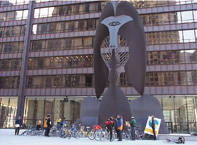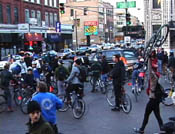are fun.
The last Friday of every month, a group of bike-riders
congregate around Picasso’s steel baboon statue in
Chicago’s Daley Plaza around five thirty. Some individuals
show up in costume, wearing signs with political and pro-bike
slogans or pulling banners and even bands on trailers. Others
show up business casual.  The
congregating period of the mass serves as a time for bike-lover
socializing as well as a nexus for other grassroots progressive
social and political movements to network -- usually through
leafleting. Activists pass out flyers for other grassroots
social and political events. Some Massers reject some flyers,
debate the validity of a cause or even join a new found
cause.
The
congregating period of the mass serves as a time for bike-lover
socializing as well as a nexus for other grassroots progressive
social and political movements to network -- usually through
leafleting. Activists pass out flyers for other grassroots
social and political events. Some Massers reject some flyers,
debate the validity of a cause or even join a new found
cause.
Critical Mass is unique because it is the event, not an
organization or institution that serves as the movement’s
structure. The actual ride is both a node for both progressive
political and social agendas shared by many of the mass
participants, and the biking sub-culture.
Individuals make routes and bring maps to the ride. These
mapmakers distribute their route to the crowd. Mapmakers
then mount the Picasso baboon and make a pitch for their
route. The crowd votes on the route it takes by cheering.
At around six p.m. the riders begin circling around the
Picasso. When most are on their bikes, the Mass breaks into
rush hour traffic and swarms through city streets for about
two hours.
Routes have taken riders through many of Chicago’s
neighborhoods. However, the rides tend to end either on
the West or North sides of the city in the Lake View, Lincoln
Park, Wicker Park and Logan Square areas (see CD-rom “The
Routes”). These neighborhoods tend to be the home
to many of the active Mass participants. Very few rides
go beyond 1800 south most likely because not many riders
live on the south side, with the exception of Hyde Park.
Some routes are designed to hit the most busy streets to
create traffic jams. In general, Mass participants are either
employed by the cycling industry in Chicago (as messengers,
at bike shops or in transportation planning), work for non-profit
corporations, are students, or work in the computer industry.
The majority of riders are white and in their mid- twenties
to mid-forties. However, there is an Asian, Latino and African
American presence at the rides and several Massers have
developed strategies to increase the diversity of the Mass.
 Masses
in the winter tend to consist of a older crowd than the
larger summer rides: Riders in the winter tend to be in
their late 20s and older.
Masses
in the winter tend to consist of a older crowd than the
larger summer rides: Riders in the winter tend to be in
their late 20s and older.
Once on its way, the Mass moves in union through intersections,
including red lights if the flow of riders outlasts the
light cycle. Several riders “cork” major intersections
by blocking it with their bodies, often holding their bike
over their heads. These blockers often wave and “thank”
the drivers for patiently waiting for the mass to roll by.
Massers yell slogans like “Happy Friday!” and
“Bikes are Better!” Occasionally, interactions
with drivers-by are less than cordial, but in general, interactions
range from blasé to friendly.

Actual routes often differ from proposed routes. Mapped
to the right are the paths that Chicago's Critical Mass
actually followed in April, May and June. Click on a ride
in the legend at right to see the proposed route.
The May Day Ride
was followed exactly, resembling a guided tour of Chicago's
Labor History.
The LaXXXhore Ride
also closely followed the proposed map. Map makers for both
of these rides remained at the front of the ride most of
these routes and kept the ride on course.
These rides were also substantially smaller than Bike
the Ike, which was "hijacked" by a friendly
police officer who participated in the mass until it swarmed
onto the expressway.



